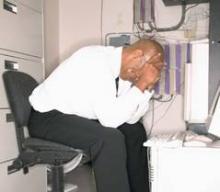User login
More than half of eligible providers did not participate in either the Physician Quality Reporting System or the Electronic Prescriber program in 2012, according to a comprehensive report released by the Centers for Medicare & Medicaid Services April 3.
The Physician Quality Reporting System (PQRS) was created by the Tax Relief and Health Care Act of 2006; the first reporting year was 2007. Physicians will be penalized beginning in 2015 if they do not successfully report the required quality measures.
In 2012, 64% of more than 1.2 million eligible health care providers did not participate in PQRS. The approximately 436,000 who did participate received incentives equal to 0.5% of their Medicare Part B allowable charges for the year. Participation in the program increased 36% from 2011 to 2012*, according to the CMS report.
The Electronic Prescriber (eRx) program was created by the Medicare Improvements for Patients and Providers Act (MIPPA) of 2008, and began in 2009.
Eligible health care providers had to report for at least the first 6 months of 2013 to avoid a penalty in 2014. Prescribers also could be penalized in 2012 and 2013 if they were not deemed successful e-prescribers.
Just over half (56%) of about 779,000 eligible health care providers opted out of the eRx program in 2012, while the 345,000 who participated received a bonus payment. That represented a 22% increase in participation from 2011. About 60,000 of those who were eligible did not receive an incentive and were instead penalized. Most (75%) eligible providers were penalized because they did not participate at all. In 2012, e-prescriptions were submitted for 13 million Medicare beneficiaries.
Overall, the CMS paid $503 million in incentives through the two programs in 2012, with $167 million going to PQRS participants, and $335 million to eRx participants. The average PQRS payment was $457 and the average eRx payment was $1,474.
These totals do not include an additional 0.5% incentive payment for participation in maintenance of certification (MOC) efforts. In 2012, some 5,600 physicians received a bonus for participating in MOC. Emergency physicians led the effort, accounting for more than 3,200 of the 5,600 bonus earners. They received $1 million in incentives overall.
Emergency physicians also had the highest number of eligible providers participating in the two incentive programs – some 65% of all eligible. Other hospital-based health care providers also had high participating rates, including radiologists and nurse anesthetists.
Internists, family physicians, and cardiologists led in reporting through claims, registries, EHRs, and accountable care organizations. About 20% of eligible internists and family practice physicians participated.
The top five measures reported to the programs were on the adoption and/or use of electronic health records; tobacco screening and cessation intervention; documentation of current medications in the medical record; pneumonia vaccination for patients aged 65 years and older; and electrocardiogram for nontraumatic chest pain (emergency medicine).
On Twitter @aliciaault
*This article has been updated 4/25/2014.
More than half of eligible providers did not participate in either the Physician Quality Reporting System or the Electronic Prescriber program in 2012, according to a comprehensive report released by the Centers for Medicare & Medicaid Services April 3.
The Physician Quality Reporting System (PQRS) was created by the Tax Relief and Health Care Act of 2006; the first reporting year was 2007. Physicians will be penalized beginning in 2015 if they do not successfully report the required quality measures.
In 2012, 64% of more than 1.2 million eligible health care providers did not participate in PQRS. The approximately 436,000 who did participate received incentives equal to 0.5% of their Medicare Part B allowable charges for the year. Participation in the program increased 36% from 2011 to 2012*, according to the CMS report.
The Electronic Prescriber (eRx) program was created by the Medicare Improvements for Patients and Providers Act (MIPPA) of 2008, and began in 2009.
Eligible health care providers had to report for at least the first 6 months of 2013 to avoid a penalty in 2014. Prescribers also could be penalized in 2012 and 2013 if they were not deemed successful e-prescribers.
Just over half (56%) of about 779,000 eligible health care providers opted out of the eRx program in 2012, while the 345,000 who participated received a bonus payment. That represented a 22% increase in participation from 2011. About 60,000 of those who were eligible did not receive an incentive and were instead penalized. Most (75%) eligible providers were penalized because they did not participate at all. In 2012, e-prescriptions were submitted for 13 million Medicare beneficiaries.
Overall, the CMS paid $503 million in incentives through the two programs in 2012, with $167 million going to PQRS participants, and $335 million to eRx participants. The average PQRS payment was $457 and the average eRx payment was $1,474.
These totals do not include an additional 0.5% incentive payment for participation in maintenance of certification (MOC) efforts. In 2012, some 5,600 physicians received a bonus for participating in MOC. Emergency physicians led the effort, accounting for more than 3,200 of the 5,600 bonus earners. They received $1 million in incentives overall.
Emergency physicians also had the highest number of eligible providers participating in the two incentive programs – some 65% of all eligible. Other hospital-based health care providers also had high participating rates, including radiologists and nurse anesthetists.
Internists, family physicians, and cardiologists led in reporting through claims, registries, EHRs, and accountable care organizations. About 20% of eligible internists and family practice physicians participated.
The top five measures reported to the programs were on the adoption and/or use of electronic health records; tobacco screening and cessation intervention; documentation of current medications in the medical record; pneumonia vaccination for patients aged 65 years and older; and electrocardiogram for nontraumatic chest pain (emergency medicine).
On Twitter @aliciaault
*This article has been updated 4/25/2014.
More than half of eligible providers did not participate in either the Physician Quality Reporting System or the Electronic Prescriber program in 2012, according to a comprehensive report released by the Centers for Medicare & Medicaid Services April 3.
The Physician Quality Reporting System (PQRS) was created by the Tax Relief and Health Care Act of 2006; the first reporting year was 2007. Physicians will be penalized beginning in 2015 if they do not successfully report the required quality measures.
In 2012, 64% of more than 1.2 million eligible health care providers did not participate in PQRS. The approximately 436,000 who did participate received incentives equal to 0.5% of their Medicare Part B allowable charges for the year. Participation in the program increased 36% from 2011 to 2012*, according to the CMS report.
The Electronic Prescriber (eRx) program was created by the Medicare Improvements for Patients and Providers Act (MIPPA) of 2008, and began in 2009.
Eligible health care providers had to report for at least the first 6 months of 2013 to avoid a penalty in 2014. Prescribers also could be penalized in 2012 and 2013 if they were not deemed successful e-prescribers.
Just over half (56%) of about 779,000 eligible health care providers opted out of the eRx program in 2012, while the 345,000 who participated received a bonus payment. That represented a 22% increase in participation from 2011. About 60,000 of those who were eligible did not receive an incentive and were instead penalized. Most (75%) eligible providers were penalized because they did not participate at all. In 2012, e-prescriptions were submitted for 13 million Medicare beneficiaries.
Overall, the CMS paid $503 million in incentives through the two programs in 2012, with $167 million going to PQRS participants, and $335 million to eRx participants. The average PQRS payment was $457 and the average eRx payment was $1,474.
These totals do not include an additional 0.5% incentive payment for participation in maintenance of certification (MOC) efforts. In 2012, some 5,600 physicians received a bonus for participating in MOC. Emergency physicians led the effort, accounting for more than 3,200 of the 5,600 bonus earners. They received $1 million in incentives overall.
Emergency physicians also had the highest number of eligible providers participating in the two incentive programs – some 65% of all eligible. Other hospital-based health care providers also had high participating rates, including radiologists and nurse anesthetists.
Internists, family physicians, and cardiologists led in reporting through claims, registries, EHRs, and accountable care organizations. About 20% of eligible internists and family practice physicians participated.
The top five measures reported to the programs were on the adoption and/or use of electronic health records; tobacco screening and cessation intervention; documentation of current medications in the medical record; pneumonia vaccination for patients aged 65 years and older; and electrocardiogram for nontraumatic chest pain (emergency medicine).
On Twitter @aliciaault
*This article has been updated 4/25/2014.

